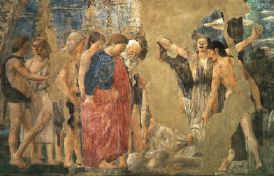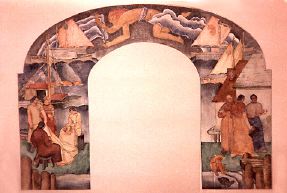|
|
Sr. Lucia Talks About Her Life as a Muralist
From an interview with Karen Ellis in 1996
Growing up surrounded by the rich history of Tillamook, Oregon

I was third born third generation Tillamook. There were four of us children in my mother's and father's family. Then my father died and my mother remarried and there were two more, two boys. And so we were a big family. I was brought up on all of the historical stories and things like that. I remember my mother pointing out to me the waterfall where Captain Gray (the subject of one of Sr. Lucia's murals) stopped and got fresh water for his crew when they sailed through (the area). And then I remember she pointed out and showed me the Indian village where the Indians, or the Flatheads, were still living when I was a child. The last Flathead was a guide just about when I was in college. Some of the Indians are still living around there. They're quite Americanized now.
So I grew up on the stories of Tillamook that way, very much of the building of the Morning Star (the ship which Sr. Lucia later depicted in a mural), and all of these things. So My mother fed my imagination right from the beginning. And so the history of the place was very much a part of my life, because my family was interested in it. It was natural that when the jobs came to me, that I would chose these subjects. So it was really my mother who really encouraged that. And she always provided me with paints and brushes and so on, from a little girl on up.
The first mural
You'll laugh at this. My first mural was a picture of a large, large painting of a point on the beach with a big cliff behind it, which we all loved. We spent some time there. And then all of the people in their bathing suits and so on, having a wonderful time. That was my first mural, when I was in high school. And I was paid in middy blouses (sailor blouses). Everybody wore middy blouses then. It was after World War I. And that was the popular style, so I was paid with middy blouses. (The mural) was shown in the store that provided the middy blouses. They helped them sell bathing suits. It was really a shop decoration. But of course I didn't know anything about murals at the time. I'd never seen one. And I never saw a fresco until I had finished all my frescoes. I'd never seen a fresco until I went to...well, I had seen a small panel painted in the Swedish style, which is a decorative style of fresco. But I hadn't seen a real fresco mural until I went to Europe after I'd finished painting.
On choosing to work in fresco...

I had a professor in college (the University of Oregon, Portland) who was a great enthusiast for Piero della Francesca (a 15th century Italian painter). So he came and taught us, and there were no reproductions of Piero at that time; I'd never seen anything of his. Remember, the first color shots that we had publicly were in Time magazine in about the 1930s. I'd never seen color reproductions of frescoes or anything. I'd seen plenty of black and white in history courses, but there were no color reproductions. I remember I won a prize for something. I can't remember what it was, and they asked me what I wanted as my reward. It could be a set of books. And I asked for a set of books printed in Germany that had color reproductions. Well, they couldn't get it; it was too expensive. So they gave me a whole set of encyclopedias! They missed the point! But I remember I was looking forward to some color shots so that being interested in this teacher's interest in, oh, his excitement, really, about fresco and about Piero, I think inspired me. So the fresco became a kind of a dream with me, you know?
Now his (the instructor's) own mural sketches in silk were not so good. He admired Piero greatly, but he missed the... he did a long panel (with) hundreds of marching people, and all you could see was feet. He missed what Piero did with feet. This teacher hadn't quite got that yet. But anyway he was an inspiration. The next teacher was the one that had studied decorative fresco in Sweden. He inspired me too. He said, "Of course you can paint a fresco." And I said, "But I've never seen a fresco," and he said, "Just treat it like a large watercolor." Well, he encouraged me, and he was a great help in how to put the materials together, the lime and the sand and all, like this. And the old janitor at the school (University of Oregon) had once been a plasterer.
On her three Oregon mural projects...

The dean of the school of architecture was very interested (in Sr. Lucia's fresco studies), and he offered me this entrance hall (Exhibition Hall, School of Architecture and Allied Arts, University of Oregon) with the four walls as my ground. (Sr. Lucia painted her first murals in fresco, collectively titled "Fishing on the Columbia River," here in 1932 as a student; the building was later torn down.) And I'd say he was so thrilled with this that when he built the (Tillamook) courthouse--this dean did the building of the courthouse--he saved spaces for murals in this hall, in this entrance lobby. What he did was panels on three walls, and I didn't choose to do the panels because for the price I couldn't have done it justice. It's much more expensive to do a series of small panels than it is to do a big one. And for the price I just chose instead to do the whole wall, and left the other panels bare. But what he did...he sent a letter (to the county judge in Tillamook) after he had seen mine, and his building was in process. (In the letter) he said that he'd designed panels in the courthouse for mural painting, and we have a young artist here who is from your area, and I think that you might be interested in having her paint these some day. That was in 1932 that he did that. I didn't know anything about it. Then when I was painting the mural ("Captain Gray" in 1943) at the (Tillamook) post office, a man came over and he said he wanted to know who I was, and I told him. He came back later and he said, "I was County Judge in 1932, when we got a letter," and this was (11 years later). He said, "We got a letter about you!" "You remembered!" He went over and he got a copy and he said, "How would you like to do a mural in the courthouse?" And I gulped and said, "Why, I'd love to."

And so the community raised the money. There was no public money in the way of a work project or anything like that. It was private donations.
Eleven people put in something. I think the people at the courthouse really knew the kind of people to ask, to get it, because there were lots of people who were cutting timber in the hills, and they went to them, so the people themselves... there was no wealth there; it wasn't made up of little tiny donations, most of them were, $500 or a thousand.
So they raised the money, and I worked. By that time I was teaching in the Portland Art Museum School, and carrying this on at the same time with sketches and all, so it was 1950, summer, before I was ready to paint it. ("The Building of the Morning Star" mural, Tillamook Courthouse, 1950; true fresco.)
"Captain Gray's First Visit to the Oregon Coast" (1943)

The way that the post office mural came about was interesting. I submitted a design in a 48 state competition that was conducted by the Treasury Department, and I won a commission for a post office, and I let my family know, naturally. And my family told some different, you know...just talking around about it, and these people suddenly got the idea, well, let's write Washington and see if they would let her do our post office. So that's the way that came out. I wasn't there (in Tillamook at the time) at all. So they wrote to Washington and to the Treasury Department, and they said, "Yes, there's a new post office there, and the 1% of the building costs applied to that, we will assign her that mural." And that's how, from that mural, the (later) courthouse mural came about, you see.
They (the people of Tillamook) are very proud of them. This building, the post office, has been put on the Registry of (Historical) Buildings. Because of the fresco in it. (Although) it's not a fresco. It's an egg tempera, that one. And this building is good for a long time yet, the courthouse. So when they had to build a new post office, they'd outgrown that one, they sold the building. Turned it over to the City Hall so it's still a public building.
Images:
(1) Tillamook County Court House, home to Lucia's "Morning Star" mural
(2) "The Death of Adam" (detail of Adam's burial) by Piero della Francesca; fresco, c.1452
(3) Sketch for "Fishing on the Columbia River" by Lucia Wiley; 1932
(4) Detail from "The Building of the Morning Star" mural by Lucia Wiley; 1950
(5) Sketches for "Captain Gray's First Visit to the Oregon Coast" by Lucia Wiley; 1943
interview ©1996 Karen Ellis; used by permission
transcribed by Emily Frank; edited by Joe Beine
|
|




